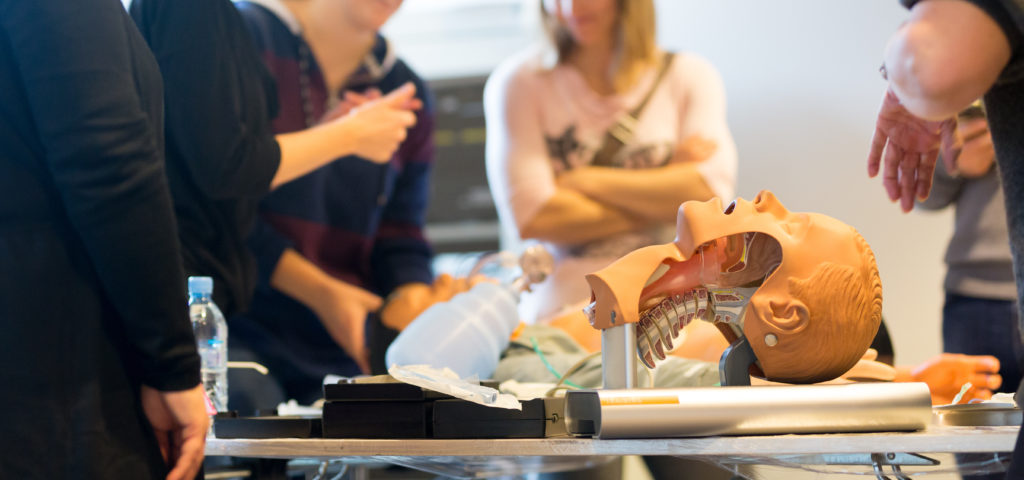When Dr. Charles Oribabor was a boy in England, he picked up an issue of Reader’s Digest that changed his life.
“Reader’s Digest always ran medical stories, but this one was different. The issue told the story of a 13-year-old boy who died of cancer. I was 12 or 13 at the time – and I was so surprised that a boy my age could die. It was then I decided I wanted to become a physician,” Dr. Oribabor recalled, then added: “Of course, if someone told me what it took, I’d have said ‘no way!’”
Raised in Stoke-on-Trent, England, Dr. Oribabor attended Obademi Awolowo University in Nigeria but ultimately practiced medicine in England before taking the U.S. medical license exam. Today he is based in a New York university hospital as an intensivist and Director of Critical Care. He also works with Tribal Health on our Critical Care Response Team.
“My rotations in ICU took me right back to that Reader’s Digest story. That’s what it was for me,” he said. “I wanted to help those people who amazed me when I was 12 years old – people who were very sick, on life support. I wanted to get them back on their feet when they were one step away from dying. It was also rewarding because when they got better, the families’ smiles would come back. So I decided to go into critical care.”
Since his training at Albert Einstein College of Medicine, Dr. Oribabor has worked in a variety of clinical environments. “I’ve seen a wide population of patients, from all areas,” he said. “Disease is disease. It doesn’t care whether you’ve got a seven-figure income or if you’re from New York, Africa, or somewhere else.”
In addition to treating a range of patient populations, he’s observed numerous changes in the field. “There’s been such a change in critical care between 2002 and 2022,” he said. “Today these hospital areas are labor intensive and equipment intensive, and they rely on multidisciplinary teams. We’re the 911 for the emergency department – it’s a handoff between us and them. And these changes in critical care structure mean we’re getting better at what we do.”

The Secret of Facility Transformation
Before coming to Tribal Health, Dr. Oribabor had not treated Native American patients before. “But I was looking for a new opportunity to help people,” he said. “And Tribal Health’s Critical Care Response Team program caught my attention.”
CCRT programs bring onsite clinical education to Indian Health Service and Tribal health facilities. The team provides reference guides, protocols, care checklists, and mock drills, assessing facility processes and policies. They also provide elbow-to-elbow instruction – training staff to perform intubations, administer COVID-19 medications, assess and treat hypoxia, manage patients on ventilators, and administer Monoclonal Antibody Therapies. By the time the team leaves, the staff feel more confident – and patients can receive care in their own community instead of being transferred.
“Coming here was an eye opener,” Dr. Oribabor said. “The patients are very appreciative of the care they receive. So I rolled up my sleeves and shared the knowledge. And yes, there are shortages of staff and equipment. But if you have the passion and desire in your heart to help someone, a lack of equipment won’t stop you.”
He added that in some ways, serving in Tribal nations reminded him of working in the Open-Heart Surgery Intensive Care Unit.
“Small things make a big difference in critical care,” he said. “In underserved populations, you may see people with comorbidities but we can fix that.”
Dr. Oribabor emphasized that in critical care deployments, his mission goes beyond than just direct patient care. “I don’t want to come, make money, and leave,” he said. “We implement new care models as well as training. Because I’ve had the opportunity to build other programs, I can see things that work, like nursing protocols. If you give me an opportunity to change the structure, I can help transform the facility.”
He added these changes can help build the team cohesion that is so critical for saving lives. “When you put something into practice and it works, that’s how you build a team,” he said. “If protocols don’t work, staff are demoralized and that’s how you get burnout.”

Unlocking Effective Patient Communication
Dr. Oribabor’s clinical philosophy places a high premium on patient communication.
“Healthcare systems do a bad job of explaining illness,” he said. “If you don’t explain how things work, patients won’t remember all the terminology and different doctors. All they’ll remember is someone came into the room. Patients have good questions but they think they’re foolish so they don’t ask. Let them ask questions and then communicate the answers in laymen’s terms.”
Recently, he shared, a 24-year-old father came into the ER. After not hearing from him, his girlfriend had visited his house and found him unconscious from substance abuse. His mother was present but hadn’t bothered to call 911. “We poured everything into helping this guy,” recalled Dr. Oribabor. “After we got his heart beating again and he was recovering, I told him what would happen if he died – that his mother, the same mother who didn’t call 911 when he needed it, would help raise his son. He got it; he turned his life around. That’s what it’s all about.”
In another example of “laymen’s terms,” Dr. Oribabor has often used an analogy of a dress factory invasion to explain COVID-19 viral infections to patients.
“There’s so much to learn, that patients can’t hear it all at once – so use analogies,” Dr. Oribabor advised. “Ideally, I sit down with patients and their family members, get the physicians involved, and explain everything. It’s a multidisciplinary conversation. The patients get that knowledge and they don’t come back.”
“Untold Stories of Excellent Care”
Dr. Oribabor encourages others to join Tribal Health’s mission of caring for Indigenous patients. “If you want to take care of some of the most underserved people in the country and make a huge difference this is the place for you. Know you’re going to have a huge impact on families, patients, and communities. You’ll take this knowledge back to where you come – and an appreciation for life.”
“Working with Tribal Health renews my enthusiasm for medicine,” he added. “There are a lot of untold stories of excellent care that’s not being highlighted. If there were patients on the dark side of the moon, Tribal Health would be the first to help.”

